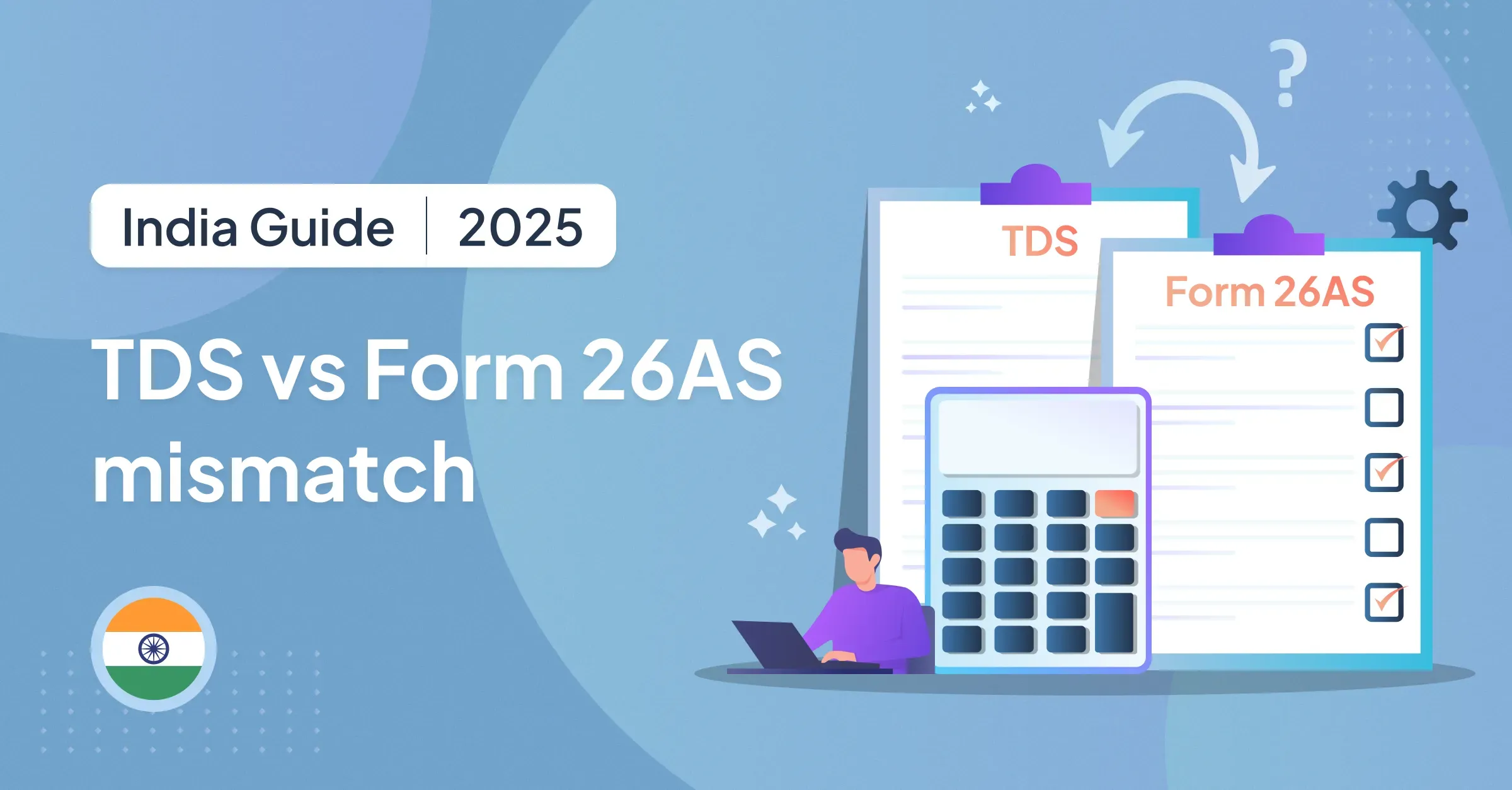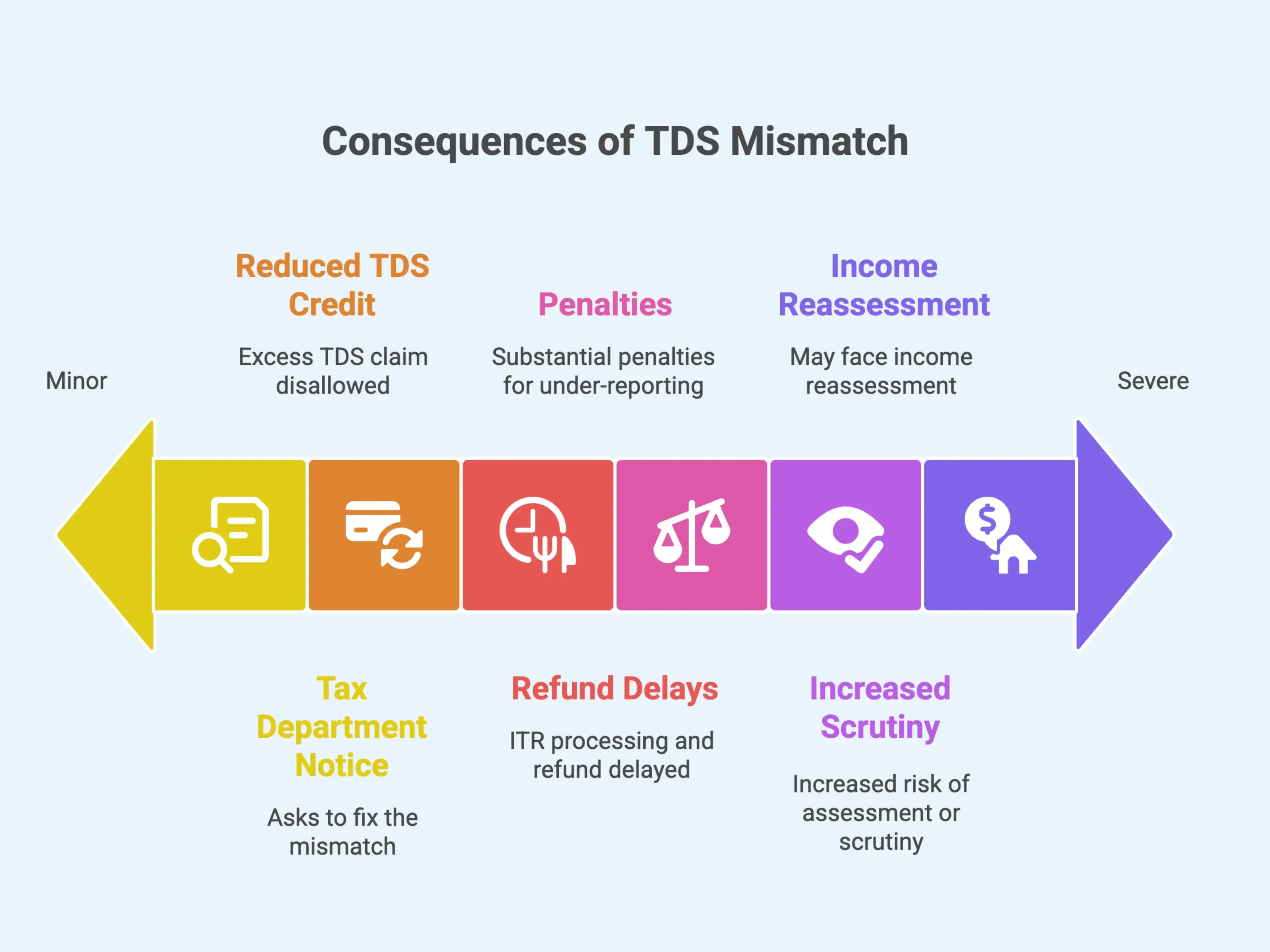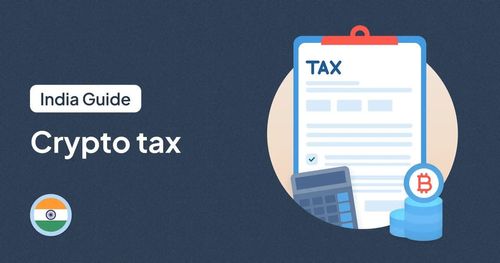
The Income Tax Department is stepping up its monitoring of Virtual Digital Asset (VDA) transactions, including cryptocurrencies. Since new tax rules were introduced in FY 2022–23, scrutiny has increased—especially around TDS (Tax Deducted at Source) compliance.
Many crypto traders are now receiving TDS mismatch notices when the TDS reported by exchanges doesn’t align with the income reported in their Income Tax Returns (ITRs). These mismatches often stem from differences between Form 26AS (your official tax credit record) and actual crypto transactions.
This article explains why these mismatches happen, how they affect your return, and what steps you can take to resolve or avoid them for Assessment Year 2025–26.
Table of contents |
No credit card required
Understanding TDS and Form 26AS
Before we move on, let’s quickly review what TDS and Form 26AS are.
What is TDS?
Tax Deducted at Source (TDS) is a way the government collects tax during the year. Whenever you earn income (like salary, interest, or virtual digital assets including cryptocurrencies), the payer deducts a part of it as tax and deposits it to the government against your PAN. If there's a TDS mismatch due to wrong PAN, that credit may not reflect properly in your tax records.
For crypto traders, under Section 194S of the Income Tax Act, 1% TDS is deducted on the transfer of crypto assets, regardless of profit or loss. This deduction is made by the exchange or the buyer and is deposited with the government against your PAN.
Example:
If you sell crypto worth ₹50,000 on an exchange, the platform may deduct ₹500 as TDS and credit ₹49,500 to your account. That ₹500 should appear in your Form 26AS under your PAN. If it doesn’t, and you try to claim the amount, you may need to claim TDS credit not in 26AS manually or follow up with the deductor.
What is Form 26AS?
Form 26AS is your official tax credit statement. It shows all the TDS deducted and deposited on your behalf, any advance tax you paid, and refunds issued. It’s what the Income Tax Department uses to check your tax payment claims.
When you file your ITR, the department matches your TDS claims with Form 26AS. If there's a TDS vs Form 16 mismatch, or if your crypto income doesn’t align with the tax credited, the extra claim will be rejected.
For crypto traders, TDS deducted by exchanges should appear here. If it doesn’t, or if your reported income doesn’t match the TDS reflected, you could receive a notice.
Why TDS and Form 26AS Don’t Match in Crypto and Other Income
TDS mismatches are becoming a growing concern for crypto taxpayers, often leading to confusion, refund delays, or even tax notices under Sections 143(1) or 139(9). In most cases, the issue arises because the crypto income reported in the ITR doesn’t align with the TDS information reflected in Form 26AS or the Annual Information Statement (AIS).
Here are the most common reasons behind these mismatches and how to address them:
Delayed or Incorrect TDS Reporting by Exchanges
Crypto exchanges may delay or incorrectly report TDS deductions, especially if there's a mismatch in PAN details or transaction data. For instance, if an exchange reports TDS under a different PAN or fails to file timely returns, the deduction won't appear in Form 26AS until corrected .
International Exchanges and Missing TDS
In some cases, transactions on international platforms like Binance or KuCoin may not have tax deducted at source. This can result in discrepancies when such income is reported in your ITR without corresponding TDS credits in Form 26AS. If you're in this situation, it's important to know how to correct TDS mismatch in 26AS and claim TDS credit not in 26AS properly.
Incorrect Classification in ITR
Crypto income must be reported under Schedule VDA in the ITR. Misclassifying it under other heads like capital gains or business income can lead to mismatches. In case you receive a notice, knowing the steps to resolve TDS mismatch notice in India is essential.
Timing Differences
TDS deducted late in the financial year might not show in your Form 26AS immediately, especially if the deductor files their TDS return after your ITR submission. To avoid this, check the timeline to fix TDS mismatch before ITR filing and confirm all TDS has been reflected before submitting your return.
If a mismatch leads to a demand or assessment error, you may have to appeal TDS mismatch assessment. Ensure that it is through the proper channel and work with your deductor to update the records.
What Happens If You Don’t Fix a TDS Mismatch from Crypto Trades
The Income Tax Department checks ITR disclosures against data that’s reported by the following:
●Annual Information Statement (AIS)
●Virtual Asset Service Providers or VASPs, which are crypto exchanges
●TDS statements that have been filed under Section 194S
●Form 26AS
Ignoring the issue can lead to serious consequences. Even small investors or casual traders are not exempt if mismatches between TDS statement and Form 26AS are found. In fact, many taxpayers are now receiving TDS mismatch notice India related to their crypto activity.

1. Tax Department Notice
The Income Tax Department is increasing its scrutiny of crypto transactions using AI, machine learning, and data analytics tools. If a mismatch is detected between the TDS reported by crypto exchanges and the income declared in your Income Tax Returns (ITR), you may receive a notice.
This notice is a TDS mismatch notice in India under Section 143(1) or 139(9). It asks you to fix the mismatch. In crypto cases, these are increasingly being triggered where TDS has been reported by an exchange, but the corresponding income is not declared in the ITR.
2. Penalties for Under-Reporting or Misreporting Income
If the mismatch arises due to under-reporting or misreporting of crypto earnings, taxpayers can face substantial penalties under Section 270A of the Income Tax Act. For under-reporting, the penalty is 50% of the tax payable on the under-reported income. For misreporting, the penalty can escalate to 200% of the tax payable.
You may also face prosecution under Section 276C for willful concealment, or interest under Sections 234A/B/C.
3. Reduced TDS Credit
You’ll get credit only for the amount in Form 26AS. If you claim ₹15,000 as TDS on crypto sales but only ₹10,000 appears in Form 26AS, the excess ₹5,000 will be disallowed, and you will be treated as under-reporting tax.
4. Refund Delays
Mismatch can delay your ITR processing and refund.
5. Increased Tax Scrutiny and Audit Risk
In recent months, several crypto investors and traders have received detailed notices requiring them to reconcile transactions, TDS entries, and income declarations. Unresolved mismatches, especially across multiple financial years, can increase your risk of assessment or full scrutiny under Section 143(2). Particularly if your crypto trading volume is high and records are incomplete.
The department has initiated bulk notices under its NUDGE (Non-Intrusive Use of Data to Guide and Enable) campaign for taxpayers who have not reported VDA transactions despite TDS being deducted at source. This was especially for cases where the amount of such discrepancy was over Rs 1 lakh.
Lastly, due to a lack of resolving or addressing mismatches, you may also face Income Reassessment under Section 148.
How to Fix TDS Form 26AS Mismatch
To help you avoid issues while filing your ITR for AY 2025–26, here are some actionable steps that can reduce the likelihood of mismatches between TDS statement and Form 26AS.
1. Check Your ITR for Accurate Crypto Disclosure
Access the Income Tax e-Filing Portal and review your submitted ITR for AY 2023–24 or 2024–25.
- Have you correctly reported your total crypto income?
- Is Schedule VDA filled as required?
- Did you apply the 30% flat tax on crypto profits, or accidentally use slab rates?
Failing to disclose crypto earnings accurately can raise red flags and may result in a TDS mismatch notice India under Section 143(1).
2. Download and Review AIS and Form 26AS
Want to know how to check TDS mismatch in Form 26AS? Start by downloading the AIS and Form 26AS from the income tax portal:
1.Go to My Account > AIS
2.Look over crypto-related entries
3.Confirm TDS deductions reported under Section 194S
If your AIS or Form 26AS shows TDS but your ITR doesn't include the associated income, it can lead to a mismatch and potential notice from the Income Tax Department.
3. Match Data with Your Exchange Reports
Sign in to each crypto exchange you’ve used and:
●Export your transaction summaries
●Compute profits or losses for the relevant FY
●Compare the figures with those reported in your ITR
Make sure your profit/loss amounts, transaction values, and TDS entries align. This process is crucial to resolve TDS mismatch India and helps you avoid refund delays or further scrutiny.
4. Submit an Updated Return If Required
Identified discrepancies or omitted income? You can fix these by filing an Updated Return (ITR-U) under Section 139(8A). This gives you a window of up to 24 months after the assessment year to make corrections.
Penalties apply when filing an ITR-U:
●25% of the extra tax and interest if filed within 12 months
●50% if submitted between 12 and 24 months
This is your best course of action if you’re asking, "TDS mismatch what to do" after identifying errors.
5. Keep Comprehensive Records
Even when you’ve filed everything correctly, maintaining supporting documents is important:
●Crypto wallet activity logs
●Trade summaries from exchanges
●TDS certificates (such as Form 16A)
●Gain/loss computation worksheets
One of the most common reasons for TDS mismatch due to wrong PAN is an error or typo in PAN details by the exchange. In such cases, coordination with the deductor is necessary to fix the issue at the source.
6. Use the right tools for crypto tax reporting
If you trade or invest in cryptocurrencies, your tax obligations fall under VDAs as per Indian tax law. Crypto transactions are taxable even if you don't convert back to INR.
Calculating crypto gains and losses manually can be difficult, especially if you use multiple exchanges or wallets. Using the right tools is important in such cases. One tool available in India is cryptact, which:
- Calculates crypto capital gains and losses
- Supports over 140 Indian and global exchanges
- Provides reports aligned with Income Tax Department (ITD) guidelines
- Helps ensure accurate reporting of your VDA activity
When dealing with crypto, use reliable tools to generate reports and cross-check with your AIS to avoid underreporting. This is particularly important as tax scrutiny of VDAs increases, and the timeline to fix TDS mismatch before ITR filing grows shorter.
Your Final Checklist
Before the tax department flags you, follow this quick action plan:
●Download ITR, AIS, and Form 26AS.
●Review crypto-related income and TDS.
●Match with your exchange records.
●File an Updated Return if necessary.
●Use the right tools to calculate capital gains and losses for exchanges, DeFi, and NFTs
●Taking proactive action now can prevent serious issues later, including the need to appeal TDS mismatch assessment or respond to scrutiny.
Conclusion
Mismatches between TDS statement and Form 26AS are common, but avoidable. Always cross-check your records, keep good documentation, and take prompt action if there’s a mismatch. Crypto users must double-check that exchanges deduct and report TDS correctly under their PAN.
To resolve TDS mismatch in India, the best approach is to work with the deductor and follow the correction steps on the portal. If you act early, you can fix the problem and avoid notices or delays.
If you're reporting income from cryptocurrency or other Virtual Digital Assets, accuracy becomes even more important. Manual calculations can be time-consuming and error-prone, especially with high transaction volumes or use of multiple exchanges. That’s where tools like cryptact can help.
Stay informed, stay accurate, and file your returns with confidence.
No credit card required





